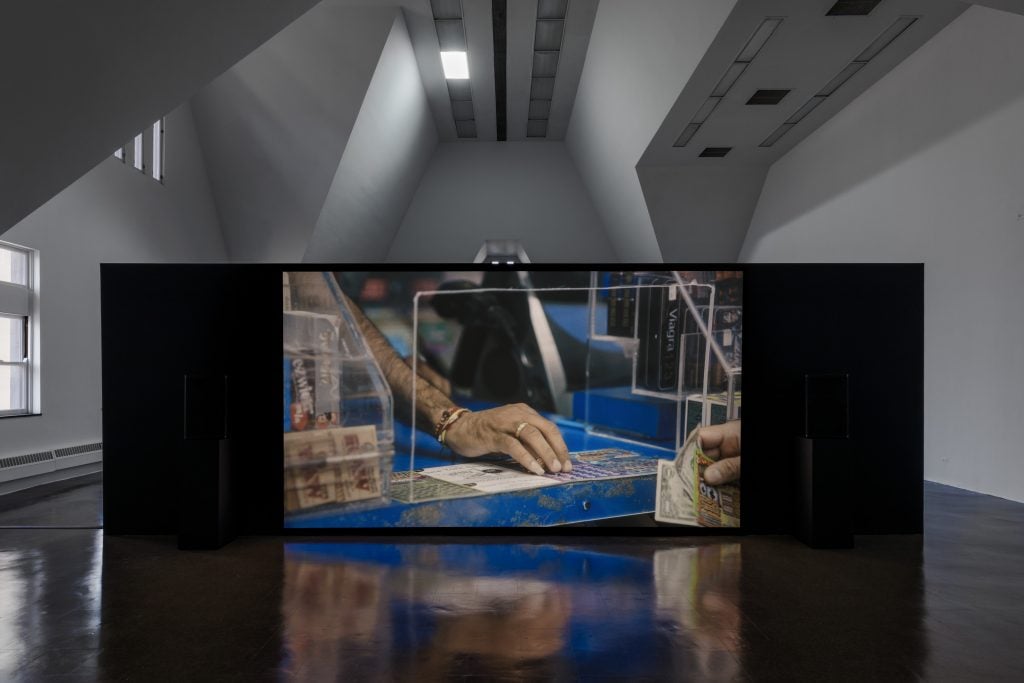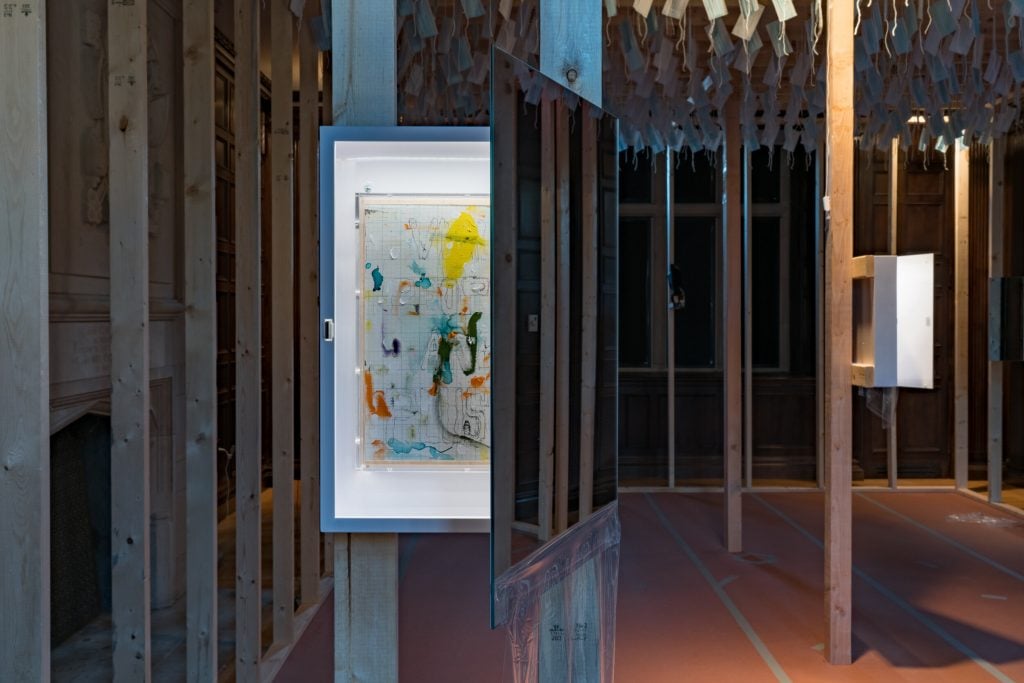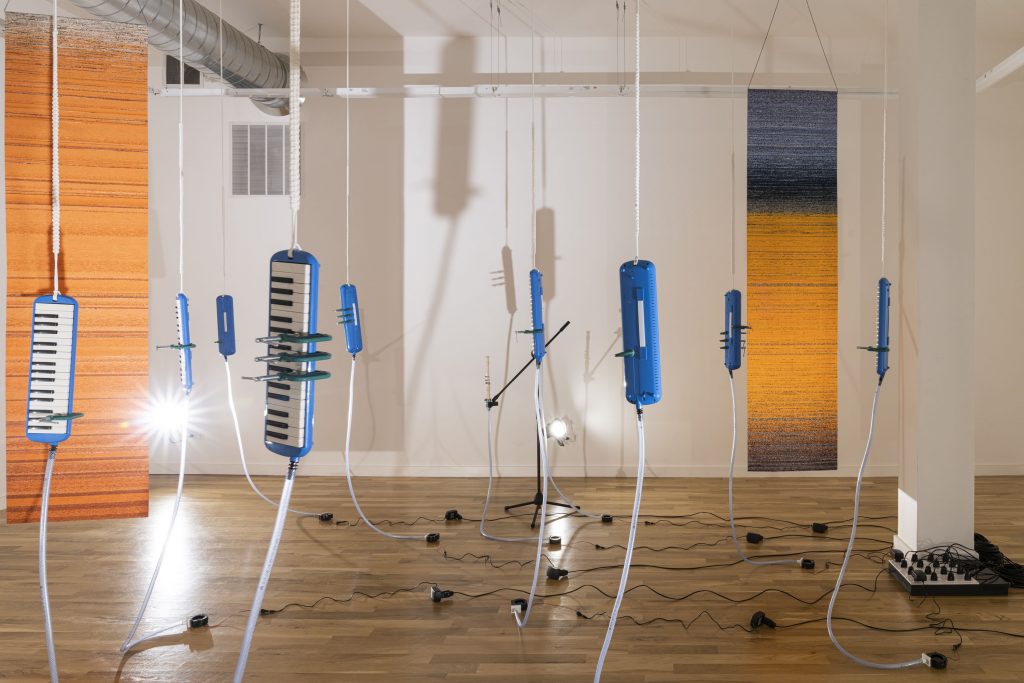Art Criticism
Welcome to Pandemic Aesthetics: How the Health Crisis Is Reshaping Contemporary Art—and Changing the Way We Look at It, Too
The "pandemic intervenes again and again" in shows by Jill Magid, Pope.L, and other artists.

The "pandemic intervenes again and again" in shows by Jill Magid, Pope.L, and other artists.

Lori Waxman

The first two exhibitions I visited in person after 409 days of seeing art only through my computer screen were Jill Magid’s “Tender: Balance” and William Pope.L’s “My Kingdom for a Title,” both in Chicago. Apart from being a fan of the artists and curious to see their new work, I chose these shows for pragmatic reasons: Their venues were located near one another and both were scheduled to close soon.
What I did not expect was how these installations would speak to one another, and to me, about the pandemic.
Magid is something of a genius interventionist, able to collaborate with institutions that seem unbreachable—the Liverpool police department, the Dutch secret service, and now the U.S. Mint. After acquiring 400,000 brand new U.S. pennies from the latter, she laser-inscribed the edges of 120,000 of them with the phrase: THE BODY WAS ALREADY SO FRAGILE. That’s $1,200 worth of pennies—the same amount as the first round of CARES Act stimulus checks. The coins were then distributed throughout the five boroughs of New York City in the fall of 2020, as part of a public artwork commissioned by Creative Time.
The clinically sparse presentation I viewed at the Chicago museum Renaissance Society included a worrisome x-ray of the artist’s young son with a coin lodged in his chest; a handful of glass pennies press-molded from amber and uranium (also scary); and a ballistics bag containing the remaining 280,000 uncirculated pennies, sitting on a metal skid borrowed from the U.S. Mint and looking eerily like a neglected baby’s crib. A 28-minute video tracked the coins’ creation and dispersal, fraught with all the episodes of touch and fear that overtook simple bodega transactions with the onset of the virus.
![Jill Magid, 2020 Glass Pattern Penny [detail] (2021). Photo: Useful Art Services.](https://news.artnet.com/app/news-upload/2021/06/jill-magid-tender-balance-uas-installation-054-corrected-1024x683.jpg)
Jill Magid, 2020 Glass Pattern Penny [detail] (2021). Photo: Useful Art Services.
Down the street, in the posh, wood-paneled drawing room of the Neubauer Collegium gallery, Pope.L framed out a scrappy room-within-a-room to display five small paintings. The floor was covered in rolls of construction paper taped together at the seams; the walls and ceiling were made of two-by-fours; mirrored medicine cabinets, their doors hanging open, housed the canvases and still wore cling film, which quivered in the breeze generated by tower fans. Also fluttering were hundreds of disposable face masks dangling from the rafters, like festive paper banners—but not. The overall impression was of a medical construction project riskily abandoned halfway through.
The paintings are new entrants in Pope.L’s “Skin Set Project,” an ongoing series of text pieces that deal with the absurdities of hue as applied to humans. For example: VIOLET PEOPLE ARE PLUSHER. People of color remain at far higher risk of dying from COVID-19 than white people, and it was hard to keep from shutting those medicine cabinets in an attempt, however futile, to protect the works from human contact.

Installation view, “Pope.L: My Kingdom for a Title” at the Neubauer Collegium. Photo: Robert Heishman.
Since that initial day, I have resumed my weekly visits to museums and galleries throughout Chicagoland. To my surprise, the same thing keeps happening: The pandemic intervenes again and again in the art I am seeing. I do not mean this in terms of the requirement to wear masks and social distance while in an art space. I mean it in terms of what art signifies and feels like. This seems to occur whether the artwork in question makes an explicit connection to our quarantine times or not.
At Western Exhibitions, Edie Fake presents “The Pieces,” a show of 26 paintings and collages, all dated 2021. Nearly every one is made up of small parts, meticulously brushed on or cut out of old books and magazines, then fitted together into symmetrical constructions pleasing in their orderliness but alarming in their precarity. Echoes of lockdown jigsaw puzzles, drug-taking, and germophobia abound, though I feel certain that if I were seeing Fake’s pictures two years ago I would be thinking instead about mandalas, building blocks, and fantasy architecture.
At DOCUMENT, the Indonesian collective Tromarama is having its first U.S. solo exhibition. “Beta” includes 16 melodicas—wind-powered keyboards typically played by school children—powered by air hoses triggered whenever someone tweets the tag #nationality. Though the central installation dates to 2019 and its references are to culture as imparted through national school curriculums, the discordant, wheezy sounds of the installation, driven by machine breathing and absent living people, haunt me like a trip to the ICU.

Tromarama, Beta (2021), installation view at DOCUMENT.
Art is not helping me transcend the fear, exhaustion, sadness, and distrust that took over my worldview this past year. Come to think of it, art has only rarely been such a vehicle for me; it has instead grounded me more fully, more critically, and sometimes—thankfully, phew—more imaginatively in the here and now.
One dependable exception to that rule has been the glorious, luminescent paintings of Mark Rothko. But not even good old Rothko, five of whose masterworks are currently occupying an entire room at the Art Institute of Chicago, could take me somewhere otherworldly on the day of my recent visit. Though I knew why, I appreciated the clues offered by the artwork with which Rothko’s canvases were sharing space: an untitled Felix Gonzalez-Torres text piece from 1989. Running around the top of the walls, right up near the ceiling, silvery words list historic events and personal milestones in the late artist’s life: Mariel Boat Lift 1980…VCR 1978… Ross 1983. Gonzalez-Torres’s instructions oblige the owner of the frieze to consider adding or subtracting events, even ones subsequent to the artist’s death, and I couldn’t help but wonder if and when the museum would add: Coronavirus 2020.